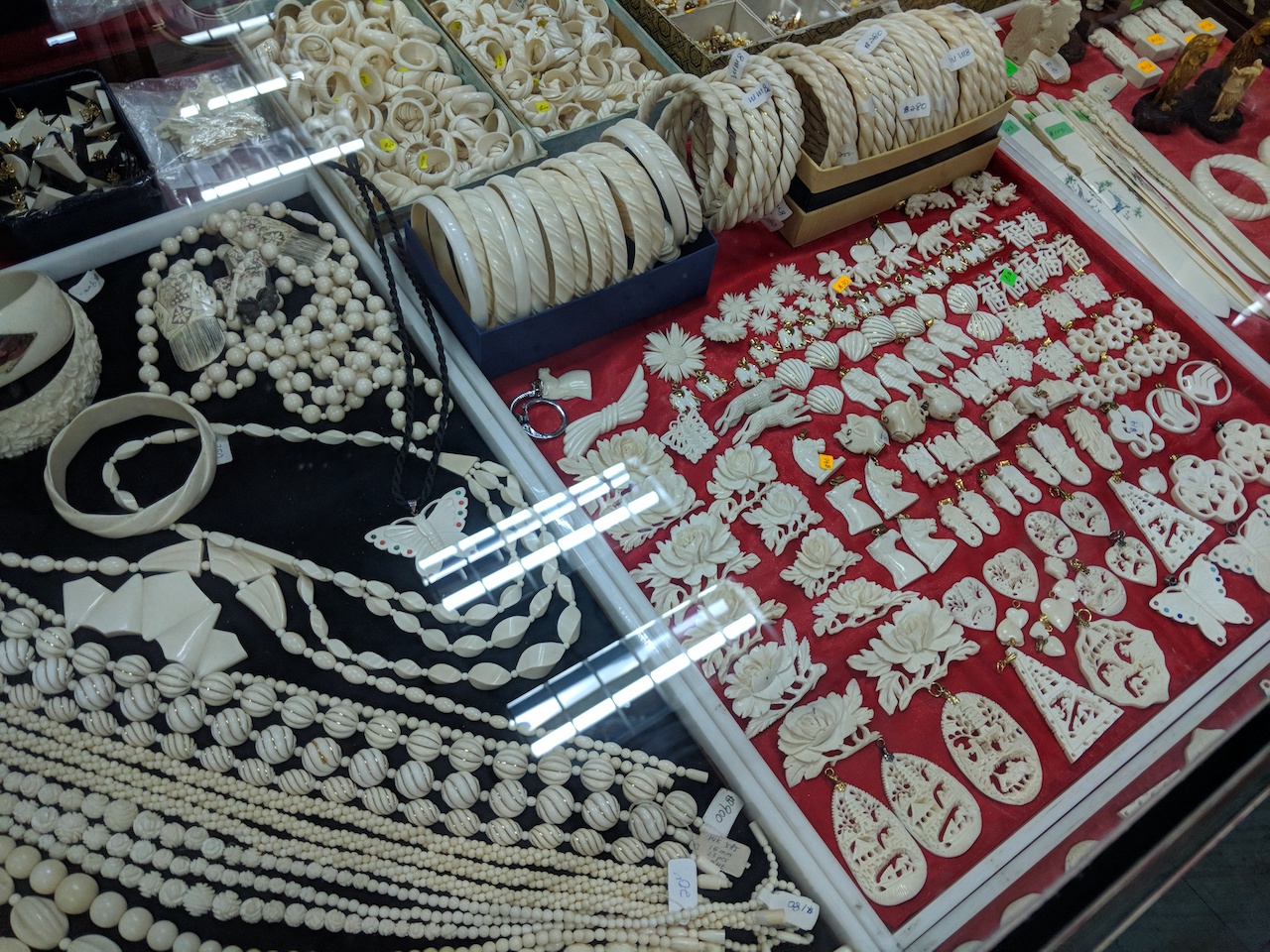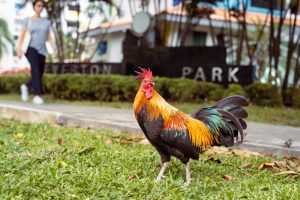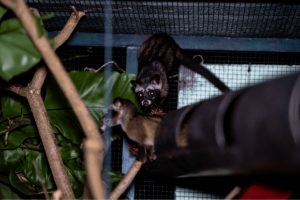Would you risk pulling an outrageous publicity stunt just to raise awareness on a serious issue few people seem to care or know much about?
If your answer is yes, you may have found yourself siding with World Wildlife Fund (WWF) Singapore when they recently revealed that they were behind Ivory Lane Singapore, a fictitious brand set up at the end of July to highlight the shortcomings of wildlife laws in Singapore. The brand was made to look like it sold accessories made of ivory.
Fashioned from elephant tusks, ivory is a rare commodity. Merely four years ago, the National Geographic reported that 100,000 elephants had been killed by poachers over just three years. Today, WWF estimates that around 55 African elephants are slaughtered for ivory every day, with their tusks turned into carvings and trinkets.
Naturally, netizens left angry comments on Ivory Lane’s Facebook page. According to WWF Singapore’s chief executive Elaine Tan in a statement to Straits Times, Singaporeans had unequivocally demonstrated that they had “zero tolerance toward illegal wildlife trade”.
The question is: So what?
After the ire, much of the coverage following the big reveal missed the point. Some who had been duped were more upset about the ethics of the PR stunt, while others were peeved at the supposed whistle-blower at ST who ‘forced’ WWF to show their hand way ahead of schedule.
So much drama, when all WWF had wanted to do was open our eyes to the horrifying fact that ivory is still being sold in Singapore in 2018, and that we lack the necessary legislation to combat this.
The thing is, even though Singapore has banned the commercial import and export of ivory since 1990, the selling and buying of ivory in the country is still allowed. In other words, all ivory products imported before 1990 can still be legally sold.
Yet just because something is legal doesn’t mean you should do it.
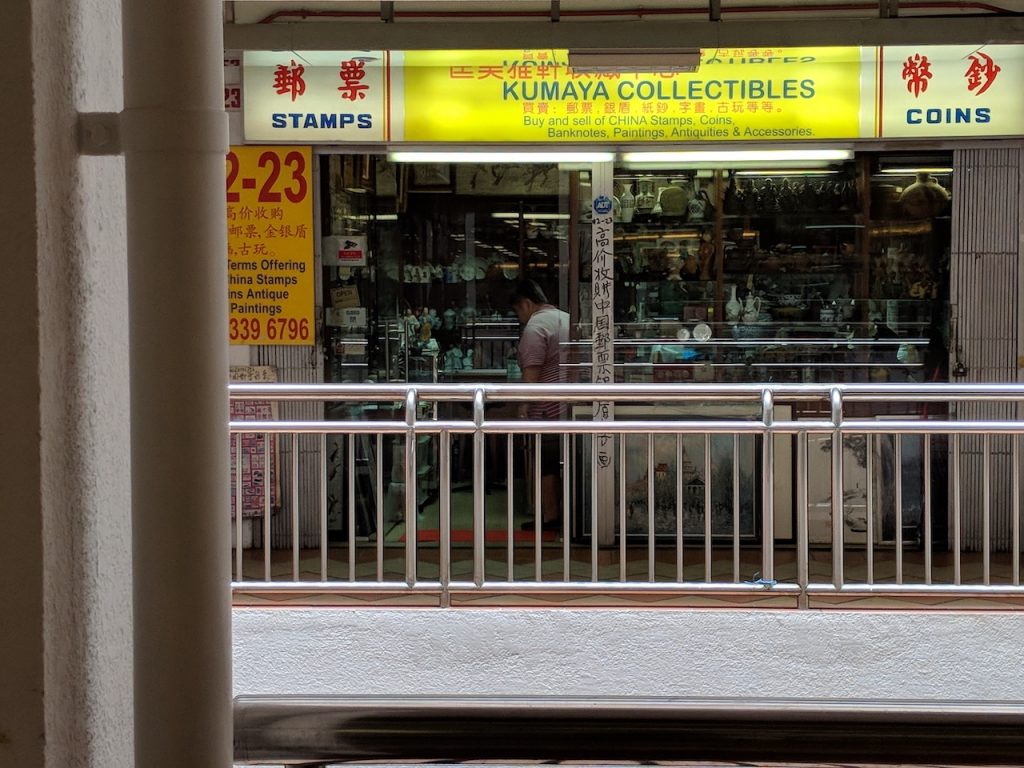
In summary, these were the stores I discovered that continue to sell products made of ivory:
- 1. LUP Trading Oriental Arts at The Riverwalk
- 2. Dragon House Pte Ltd at Lucky Plaza
- 3. House of Destiny Arts & Crafts at Fu Lu Shou Complex
- 4. H M Art Gallery at Fu Lu Shou Complex
- 5. Toh Chwee Huat Ivory Company at Bras Basah Complex
- 6. Art Gallery 3 at Bras Basah Complex
- 7. Kumaya Collectibles at Bras Basah Complex
- 8. Chinatown Seal Carving Souvenir at Lucky Chinatown
- 9. Majestic Mandarin at Pagoda Street
Before entering each of these stores, I turned on my phone’s recording function for backup. Whenever I could, I also took photos of their ivory products.
However, some interactions were more notable than others. I share the following to illustrate the continued ignorance and/or indifference to the ivory trade, raising questions that WWF’s campaign may ultimately have limited effect, no matter its reach.

This is my first stop, where I put my cover story to test. How do you get someone who might be aware they are doing something unethical to admit their wrongdoings? I knew I couldn’t approach these ivory stores as a Singaporean, much less a journalist, for fear of raising suspicions and causing these store owners to clam up.
Back in July, when I’d scoped out stores around the Chinatown and Golden Mile areas, I had gone with the exact story about wanting to buy a present, but used Mandarin as my default language. Most of the store owners had been downright evasive.
And so for a day, I was a clueless American tourist who wanted to buy a gift for her cousin’s 30th birthday. In order to get the stores to take me seriously, my ‘budget’ was a hefty $2,000.
It worked.
Gesturing to the bangles on display that I have my eye on, the elderly store owner smiles, “This one ivory. This one, the carving lotus. This one bangle. This one also ivory. Small one? Yeah this one old one.”
I counter, “Old meaning how old?”
“I think maybe 500 years. This one, new one. This one also a little bit old. Yellow colour.”
When I ask how recently he got the “new one”, he replies, “Maybe 10 years, 20 years. This one old already.”
He then goes on to share that these ivory accessories come from “India and Africa elephant”. As proof that these are authentic ivory, including the monk and Buddha ivory statues I take a particular interest in, he shows me the prices almost illegibly scribbled on the accompanying price tags: $1,200 and $1,800 respectively.
Noticing my hesitation, he generously offers, “Can less 50% for you.”
There is also a statue of Guan Yin “for protection”. It is $4,200.
Then just as I decide to make a move, his voice cracks with the desperation of a salesman unable to close a deal.
“This one also ivory! New, new, new. Brand new! 20 years, 30 years. Old one, maybe 50 years or over. 100 years.”
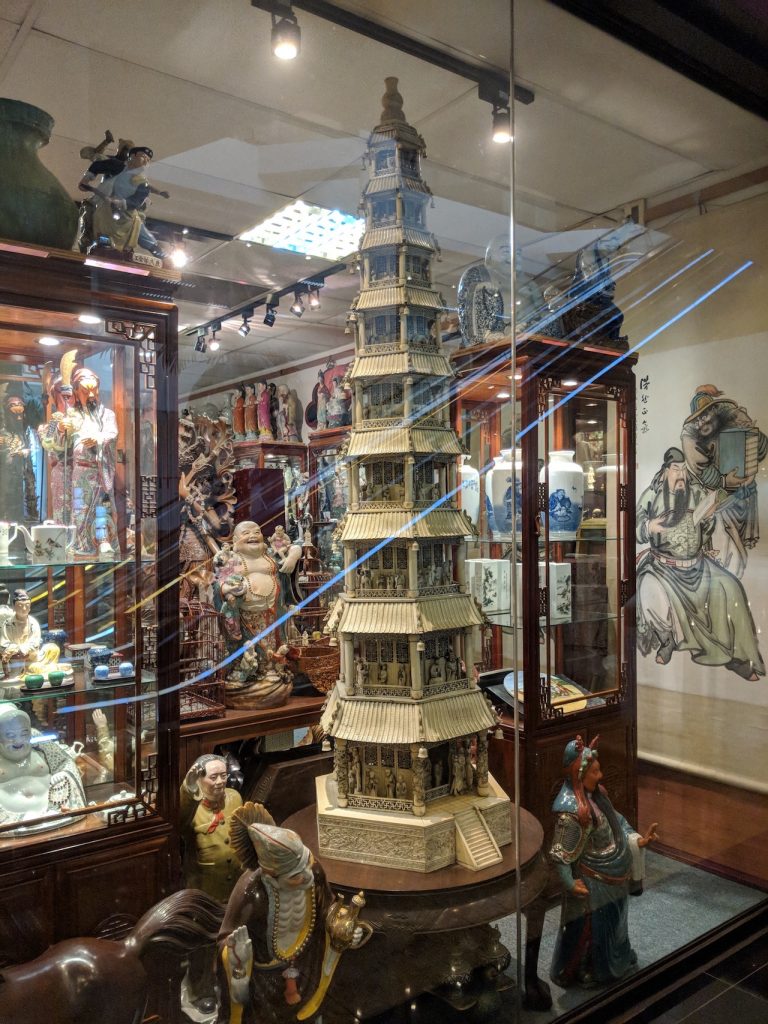
What draws me to this particular store located right beside Canvas club is the towering ivory sculpture of a pagoda right in the window. It’s at least a metre tall—hardly something that’s easy to miss.
I start by asking, “I’m looking for a present. Can I find out more about those statues?”
I point to a few small ivory figurines in a glass case inside the store. (After perusing a few stores, I am mostly able to tell what’s made of ivory.)
“Which ones? Those? Ivory. These are all made of ivory.”
“Any particular meaning? Does it bring luck?”
Suddenly the store owner sets down his paperwork that he’s been toiling over since I entered the store. He shoots me a furtive glance, as though he’s seen through my ruse.
“I don’t know, I don’t know. But anyway these are illegal now. Can’t buy anymore.”
He proceeds to tell me that the ivory sculpture I see in the window is a “private collection” and “just for show”.
If I were to give him the benefit of doubt, I should take him at face value. I try to convince myself there’s nothing ‘wrong’ with just displaying ivory. But my gut tells me he’s lying—the hugeass sculpture is in the bloody window, for goodness sake.
No one in their right mind would display something so controversial so prominently when they aren’t hoping it will fetch an exorbitant price.
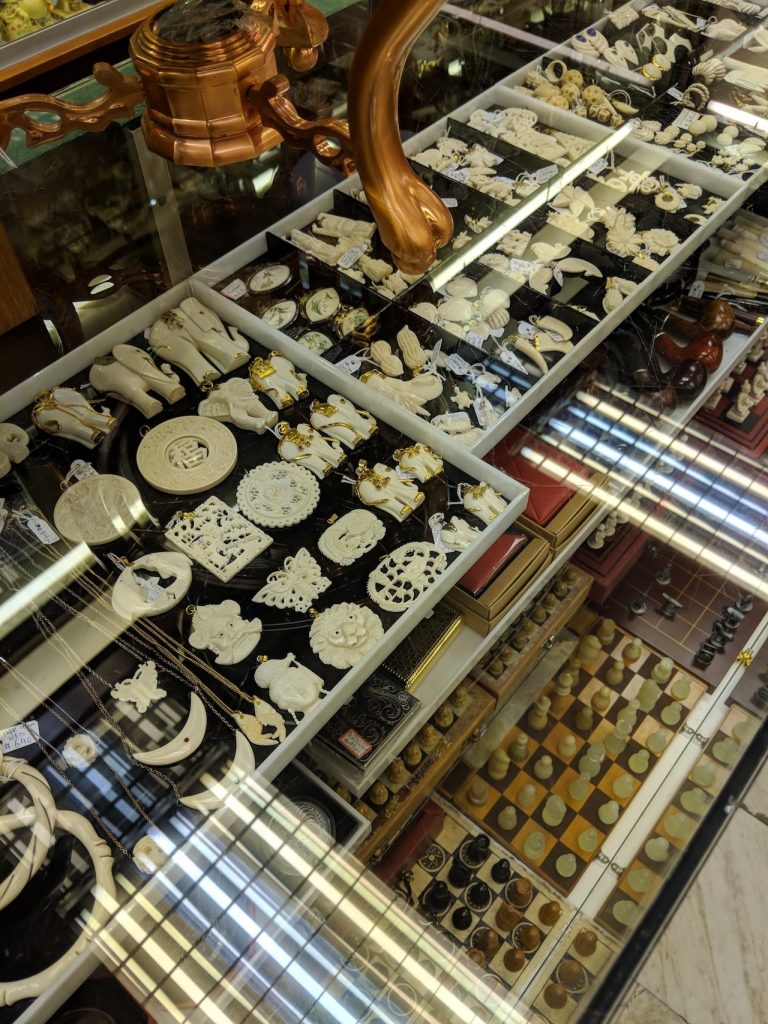
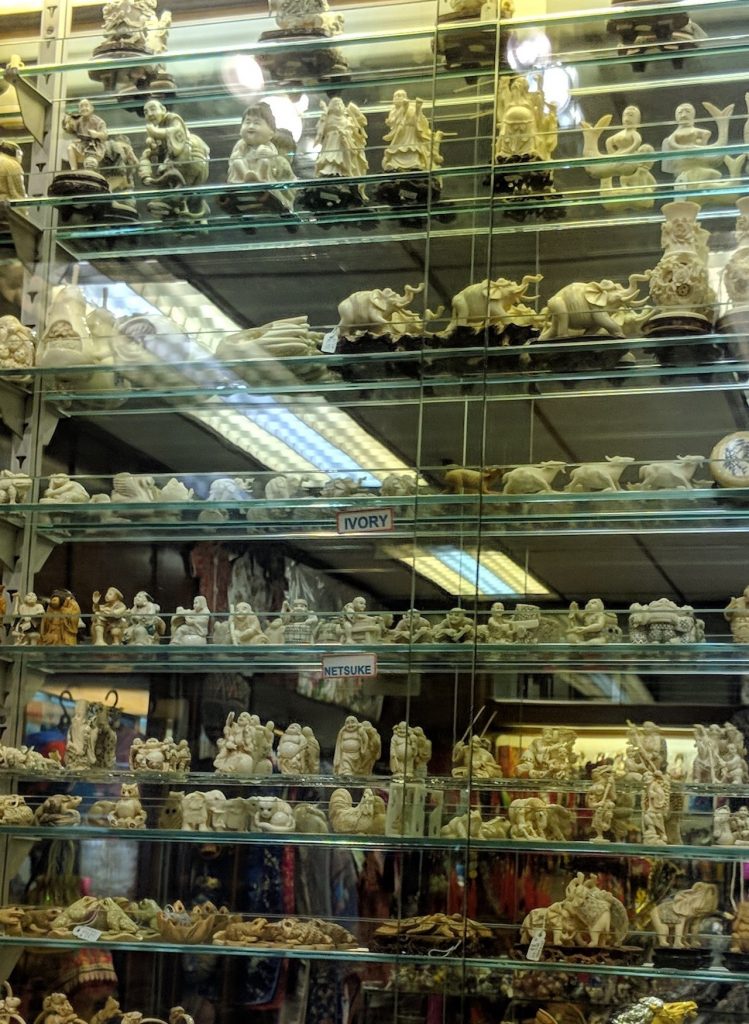
I arrive in Orchard Road following a tip that this store specialises in ivory. The tip is accurate; ivory accessories and statues are placed among other products. In fact, the entire rack behind the counter is proudly labelled, “IVORY”.
“You can get [your cousin] some earrings if she wears,” the elderly female store owner suggests. “Yeah yeah we sell quite a number. Once finish, no more.”
She adds, “Old one is good. New one you cannot buy back anymore. Old one is better. About 40 years like that. All these are hand carved so no two pieces are the same. Ivory is very hardy, not easy to carve.”
“And these are real?” I ask.
“Of course, of course!” she replies instantly.
I point to some necklaces draped on a hook behind the counter. Before I can ask anything, she replies, “Yeah ivory.”
“This is all we have. No more already. All finish.”
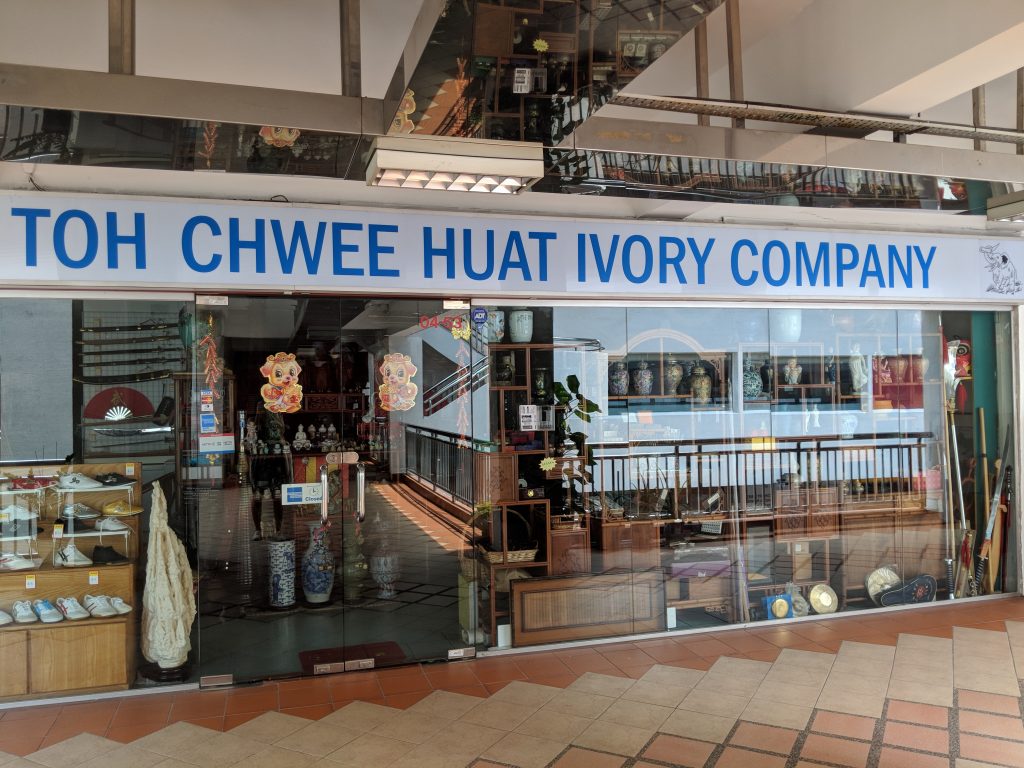
While the previous store owner’s forthcoming replies about ivory are surprising, this store truly takes the cake. Located at the corner of the fourth floor of Bras Basah Complex, this large store is instantly noticeable for its on-the-nose branding. At least I don’t need to be as careful with my words.
I’ve never seen more ivory in my life. The cramped store is packed to the brim with ivory sculptures, jewellery, and other pieces of art. In each glass case, the ivory sculptures take up every inch of the racks.
I decide to ask about the jewellery.
“All these are ivory. Now stock balance not much. Not allowed for import and export. So we sell while stocks last. This is all the balance,” I’m told.
The elderly female store owner shares that these were imported “very long ago. 10 to 20 years ago”. She informs me that they do wholesale, so they have a lot of balance.
I feign a typical tourist’s concern of getting my money’s worth, “This is authentic ivory right? I mean, I don’t want to fork out for something fake, you know?”
“Ya, we are ivory company,” she confirms.
“You come here is 100% real.”
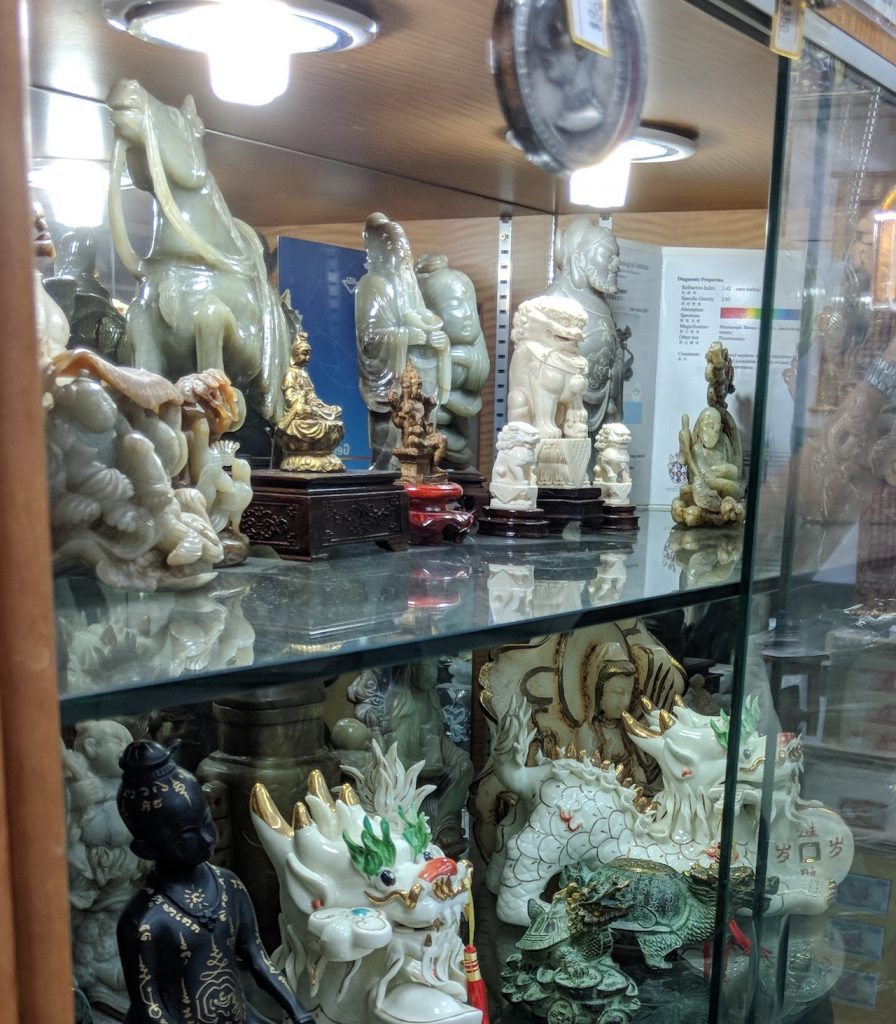

This unassuming store on the third floor of the mall is brightly lit and welcoming. Plastered on its walls are notes of old Singapore currency.
I state, “I was looking at this owl. It’s really beautiful. What’s it made of?”
“Made of ivory,” the store owner smiles. “Ivory is a bit expensive.”
“No it’s fine! My budget is actually around $2,000.”
Just like that, the store owner opens up, “Then in that case you can buy something like the Chinese guardian lion. This one will bring you luck. In front of the empress palace are two small lions. This is for people of very high status. That means when you put this in your place, it jack up your status. Officer, high rank people onwards have this.”
“I notice this is the same colour as well. Is this also ivory?”
“This is ivory. This is Buddha. $2,800. These days not easy to get things like this. This is more expensive. I also very much love ivory. I collect this one for my interest,” he says.
Unexpectedly, he gives me advice on how to identify real ivory, so I don’t get cheated of my money.
“Some are not ivory. They are made from animal with tusk that look like ivory. Ivory very easy to distinguish. Must have a vein.”
He turns over one of the ivory statues to show me a tiny black dot on its base. It’s the vessel that supplies blood to support the ivory growth; if this isn’t present, it’s not ivory.
“Oh great! Because I don’t want to buy anything that’s fake,” I say.
The following few seconds of silence feel like hours before the store owner jumps back in, “No no definitely not. I can issue you an invoice. But I cannot put ivory. Because ivory is trading concern. In many places prohibited.”
Secretly, I’m pleased with myself for using one of the oldest interview tricks. When faced with awkward silences, most people will rush to fill in the gaps themselves. Occasionally, this makes them put their foot into their mouth by blurting out incriminating responses.
I doubt the store owner can possibly say anything else to put himself in a worse light. Alas, I’m sorely mistaken.
“This one if you want, I give you some discount. Nowadays to get people to carve this is not easy. These sort of things, take a long time to learn. You must have the interest.”
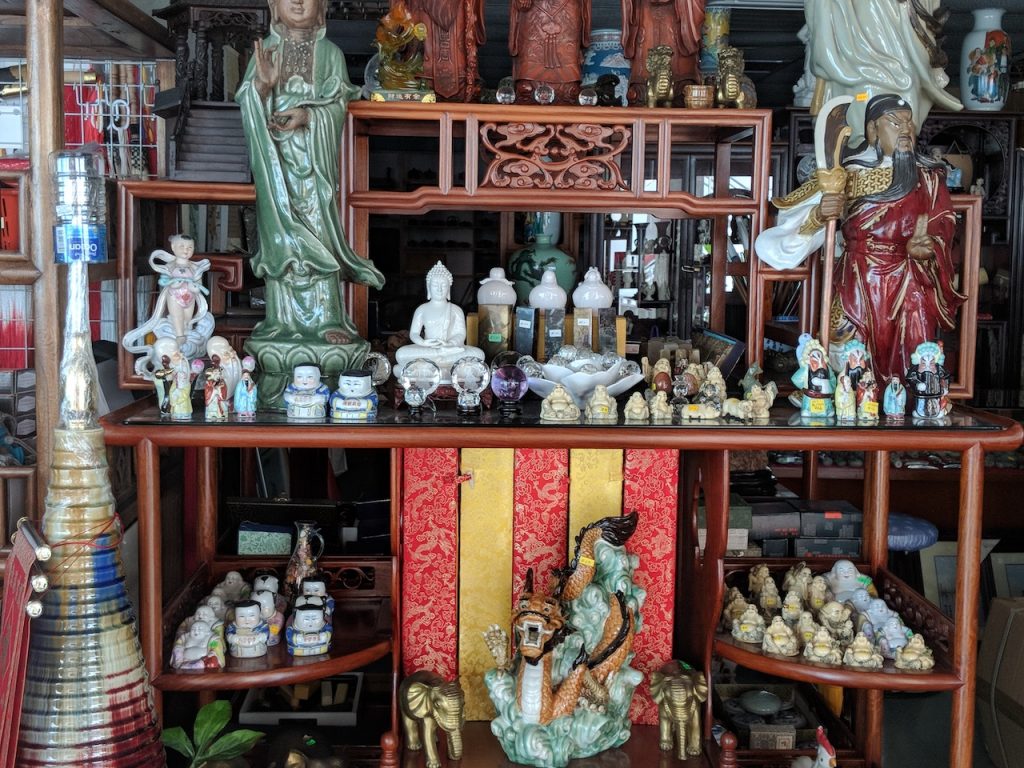
I’m aware that deceiving these store owners in order to get them to reveal things that they wouldn’t have otherwise said isn’t completely ethical either. I also spoke solely English specifically to direct the focus away from my questions; most store owners tend to be Chinese educated so they were more intent on helping me understand what they meant.
Furthermore, I understood the power of calculated flattery. When I sensed someone was reluctant to let on more information, I would compliment them on their splendid taste in the ivory products they kept. Usually this would help them feel comfortable enough to remain open.
Granted, some might argue that these store owners are usually older than 50, so I should pardon them for their ignorance. Besides, they’re just trying to make a living; having already invested capital in this, all they want is to make a profit.
Here’s what I want to make clear: It’s not about absolving individual store owners of blame, but recognising that the fault lies less with them and more with the absence of a hardline stance by the government.
If we want things to change, the precedent must start at policy level. Even though the Agri-Food & Veterinary Authority (AVA) already says it maintains a “firm stance” against illegal ivory, the least that average citizens can do is put pressure on them to enforce bulletproof legislation that stops the selling of all ivory for good and prosecutes perpetrators.
All this so that the next time we have this conversation, we don’t circle around similar PR stunts. Once campaigns blow over, we become engulfed once again in the same silence and apathy.
After all, awareness without action is an insidious poison that can make us believe we’ve already done our best.

